Page 1 of 5
Nova Sgr = PNV J18365700-2855420
Posted: Mon Mar 16, 2015 4:52 pm
by Jon
Hi all,
I have taken a low-resolution (R=260, 150 l/mm) spectrum of this. The spectrum appears to be that of a Fe II nova shortly after maximum. Prominent lines of Fe II are already showing at 4924-5018-5169 and 4491-4629. Strong P-Cygni profiles evident; at this low resolution the ejecta velocity appears in the region of 1400 km/s (+/- 250 km/s).
I'm currently collecting higher-resolution (1800 l/mm, R=c.8000) data of the H Beta region and redwards, including the iron forest around 4924-5018-5169, so should get a much better velocity calculation from that.
Cheers
Jonathan
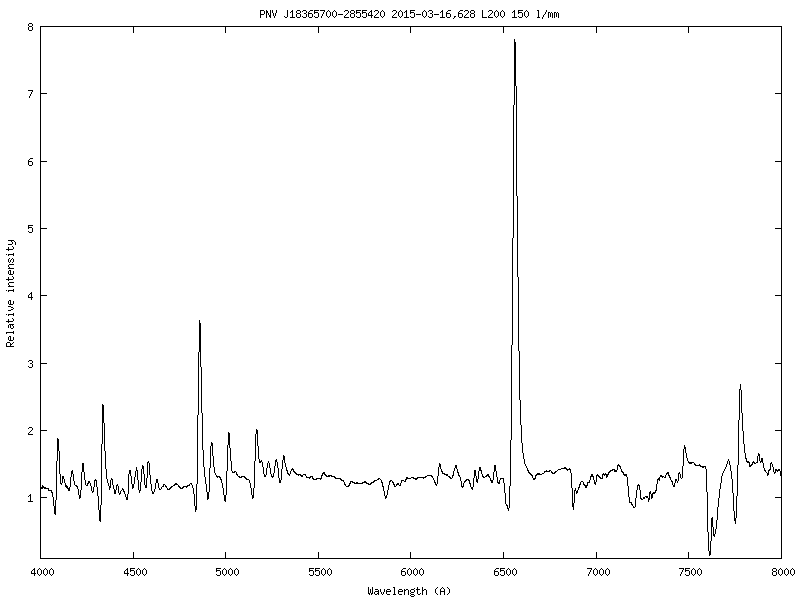
- 150.png (6.68 KiB) Viewed 23958 times
Re: Nova Sgr = PNV J18365700-2855420
Posted: Mon Mar 16, 2015 5:24 pm
by Francois Teyssier
Hello Jonathan,
The spectrum is excellent.
Good confirmation of that bright nova.
Of course, the fit is welcome in the data base
francoismathieu.teyssier (at) bbox.fr
Expecting the images of further spectra
All the best,
François
Re: Nova Sgr = PNV J18365700-2855420
Posted: Mon Mar 16, 2015 9:48 pm
by Paolo Berardi
Great spectrum Jonathan! Thank you for sharing.
François, we have another very big classical nova event! A Nova Del 2013 twin? Some say that every nova is different...
Due to its negative declination, I will never see it from my observing site...

Paolo
Re: Nova Sgr = PNV J18365700-2855420
Posted: Mon Mar 16, 2015 9:55 pm
by Jon
Here is the high-resolution data. 2 hrs data on the region 4770-5190, showing the H Beta and several of the iron lines. JD 2457098.2097
Ejecta velocity c.1100 km/s in this spectrum.
Cheers
Jonathan
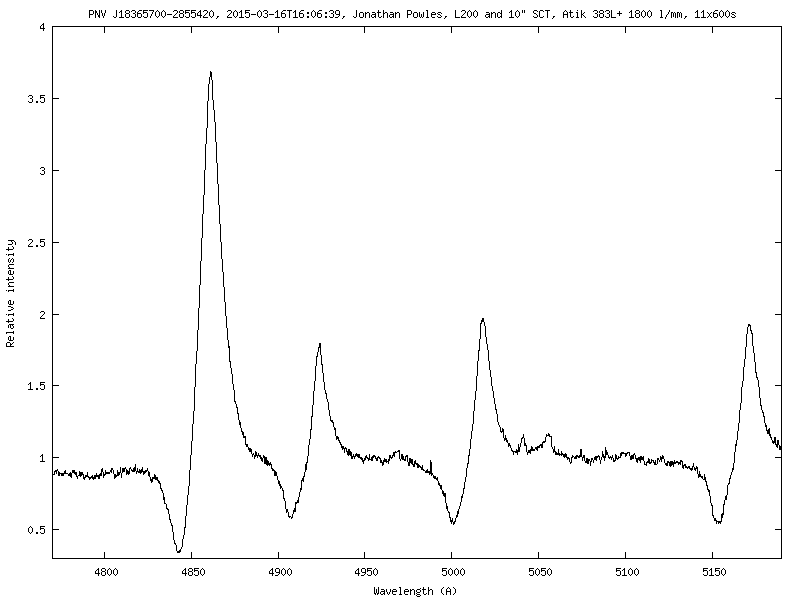
- 1800.png (7.18 KiB) Viewed 23935 times
Re: Nova Sgr = PNV J18365700-2855420
Posted: Tue Mar 17, 2015 9:45 am
by Francois Teyssier
That's excellent !
The maximum velocity can be estimated from the blue edge of the absorption.
For H alpha, it gives 6500 A
So a maximum velocity of 2800 km/s (the same as the pubished value in astronomer's telegram)
Spectra in the database :
http://www.astrosurf.com/aras/Aras_Data ... 2-2015.htm
Steve Shore :
"this might be interesting, it should be a gamma source (the observations have
started). Nothing to indicate the type yet, just that it's opaque"
All the best
François
Re: Nova Sgr = PNV J18365700-2855420
Posted: Tue Mar 17, 2015 2:59 pm
by Christian Buil
Observation of nova Sgr 2015 2 , the 17.2/03/2015 by using eShel spectrograph and a Newton 8-inch f/5 telescope (30 min. exposure) from Toulouse (France):

A detail (compare with Jon's spectrum):

A view of Halpha line after H2O telluric lines removed:

Christian B
Re: Nova Sgr = PNV J18365700-2855420
Posted: Tue Mar 17, 2015 7:42 pm
by Christian Buil
Condition of the observation from the southern France... and from my polluted observatory (Lumix GM1 APN + Leica Summilux 25 mm f/1.4):
Les conditions d'observation de la nova au petit matin depuis mon observatoire) :

The telescope is pointing toward the direction of the nova (the Moon is visible at the left:
Le télescope Newton de 200 mm équipé de la bonnette à fibre pointe vers la nova :

Christian
Re: Nova Sgr = PNV J18365700-2855420
Posted: Wed Mar 18, 2015 6:38 am
by Francois Teyssier
That's great Christian !
An excellent spectrum in such poor conditions
Comments from Steve Shore about the first spectra :
The C I 7115 line appears to be present in the latest spectrum,
Francois, as it was rather early in V339 Del. There's still more to
develop, i would be very important if the region from 6800 - 7200 A
were well covered (the echelle data is superb). The maximum velocity
and line profiles (and the current absence of [O I]6300, 6364) all
point to a relatively normal, likely nearly spherical outburst with
likely maximum velocity of -2500 to -3000 km/s (were we to see the
absorption in P Cyg on the resonance lines). There aren't spectra
extending to O I 8446 so I can't say whether O I 1302 is optically
thick but the presence of strong Fe II 5018,5169 (nearly identical
profiles but with some structure indicating th beginning of the first
transition in the absorption) and Na I 5889,5895 in emission (and with
P Cyg at about the "normal" velocity of -600 km/s) all are very much
like V339 Del during the first two weeks of the outburst. The optical
depth should rapidly decrease in the next week so daily or semi-daily
monitoring would be very helpful. There are Fermi observations already
taken and the observations will continue for the next two weeks.
The spectra are really wonderful!
Observations scheduled in gamma rays :
Fermi ToO 070602-1-1
A ToO observation to observe NOVA SGR 2015 NO.2 at RA, Dec = 274.2375, -13.9283 (J2000) was approved at 2015-03-17 14:47:50 UTC.
The justification for the ToO is: Discovered at 6.0 mag Mar 15.634 UT, incoming reports of classical nova N Sgr 2015 no.2 (AAVSO alert 512) indicate rapid rise to naked-eye peak mag 5.3 (Mar 15.802), and declining to 15.8-6.1 mag on Mar 16 (today), i.e. in early optically thick fireball stage. If similar to other optically bright classical novae, N Del 2013 and Cen 2013, LAT g-ray >100 MeV detections with fluxes (0.3-1)E-6 ph/cm2/s are expected beginning 1-2 days after optical peak. The origin and site of novae g-ray emission is still unclear and 5-day Fermi ToO ensures sufficient exposure to probe similar flux levels of previous LAT detected novae at similar stage. N Cen showed optical and g-ray rebrightening 9-days after first optical peak, so request for continuation past 5 days conditional on N Sgr optical evolution.
The planned duration is 432.00 ks.
The autonomous request threshold during this ToO is LOW.
The ToO observation should begin between 2015-03-17 14:47:49 UTC and 2015-03-24 14:47:49 UTC.
The ToO observation was requested by DR. CHI (TEDDY) C CHEUNG.
François
Re: Nova Sgr = PNV J18365700-2855420
Posted: Fri Mar 20, 2015 11:05 pm
by umberto sollecchia
Bonsoir, ce matin je ai observé l'nova en Sagittaire. Voici le profil.
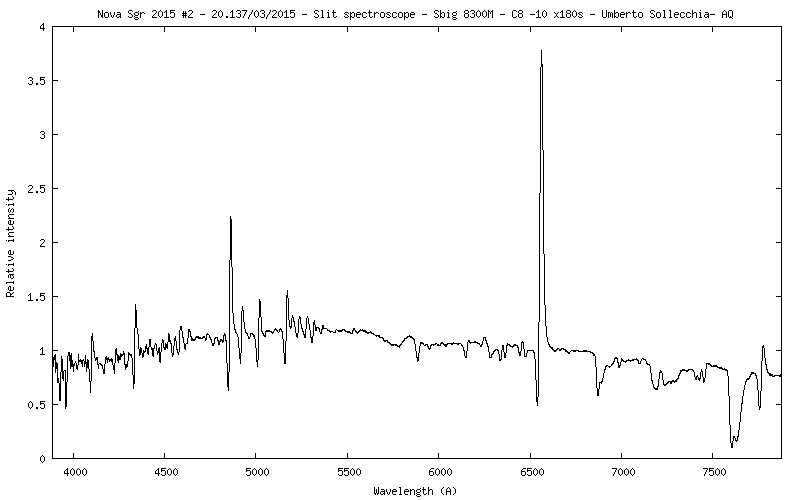
- _novasag2015_20150320_137.png (6.48 KiB) Viewed 23610 times
Umberto
Re: Nova Sgr = PNV J18365700-2855420
Posted: Sat Mar 21, 2015 12:41 am
by Jon
Here is a low-resolution spectrum from 18-3, and a comparison of the central section of the low-res spectra from 18-3 and 16-3. Interesting to observe the deepening of the P Cyg profiles and the reduction in expansion velocity over those two days.
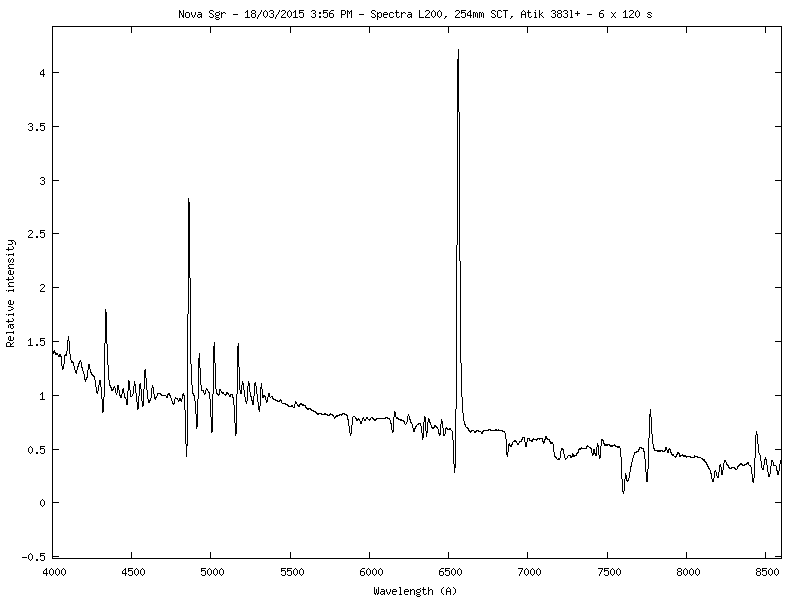
- _novasgr_20150318_664_JPowles.png (6.99 KiB) Viewed 23602 times
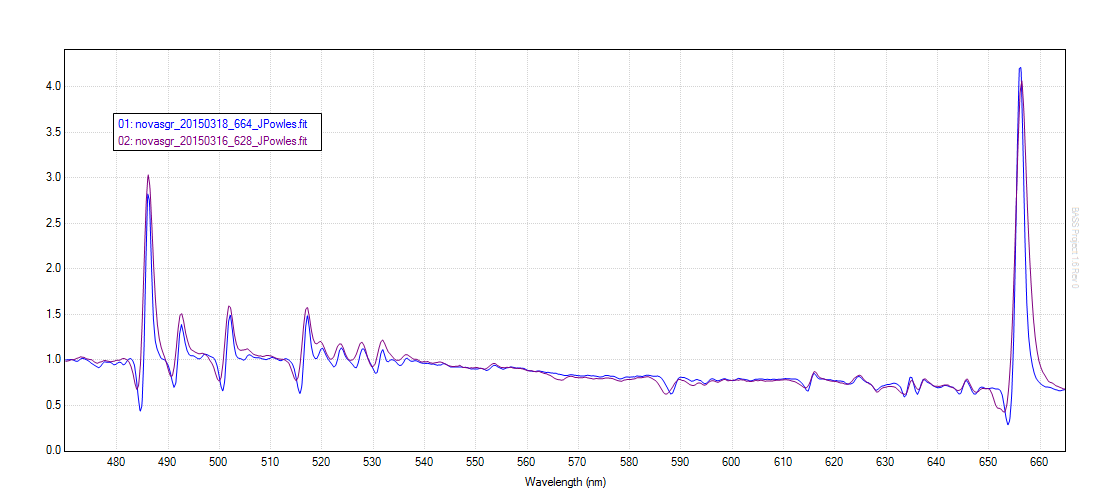
- 16-18 comp.png (37.8 KiB) Viewed 23602 times




